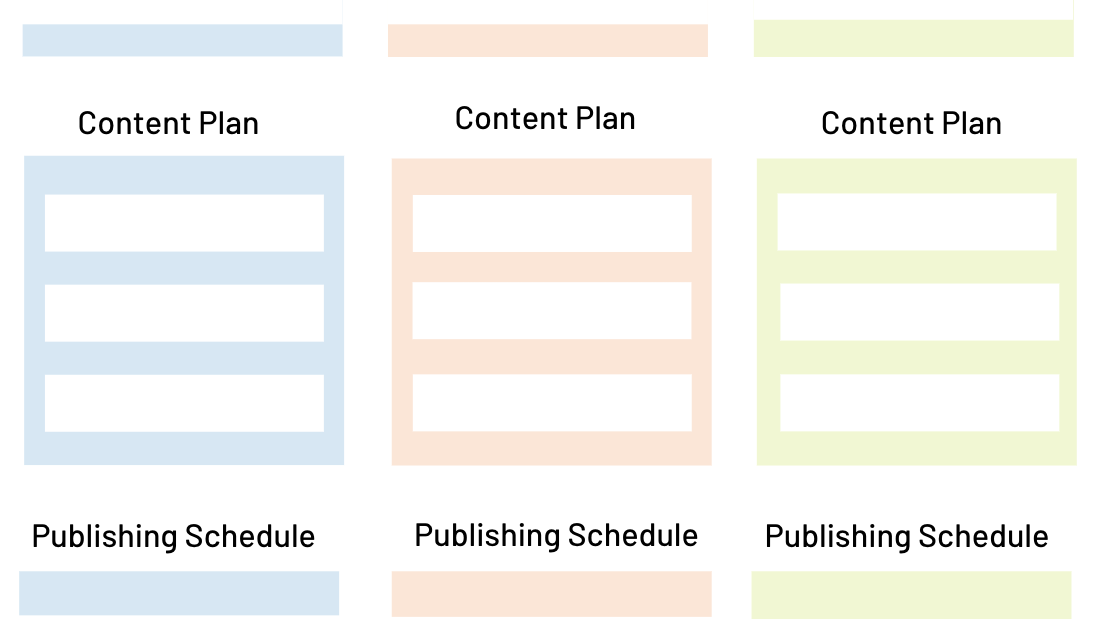Evaluate 3 types of content strategy frameworks
Your content strategy involves planning the subject matter, structure, and schedule of producing web content. At a basic level, websites usually have some sort of service pages that are regularly updated and a stream of blogs relevant to the business offering. Producing these types of content is the first step of your strategy.
Now, let’s take it a step deeper. How can you produce and organize content in a way that creates even more value? The types of content you create, and how you organize, can:
Boost rankings
Direct people to pages that are common points of conversion
Keep a reader on your website longer
All of these factors tie into increased organic traffic and conversions - likely your top goals for generating content.
So how do you get there? Here are some popular methods for organizing content for SEO.
Hub and Spoke
What is Hub and Spoke?
The Hub and Spoke content model involves creating a main page that acts as sort of an index. In whatever format you choose, this page is a hub of links to other relevant content.
For example, my content planning resources article is a hub for content targeted towards content specialists. Likewise, my small business marketing resources article is a hub for content targeted towards small business owners.
What are the benefits of Hub and Spoke?
The Hub and Spoke model has two main benefits. First of all, it makes backlinking easier. Instead of working to get links to every piece of content, you can focus on getting a few quality links to the hub page. In turn, the hub page passes this link authority along to each piece of content.
Secondly, these hubs are great for sales enablement and marketing campaigns. Having a central hub of resources bundled by persona shows your expertise. Plus, you can track where people click to see which content resonates with them best.
Topic Pillars and Clusters
What is the Topic Cluster Method?
HubSpot first introduced the Topic Cluster method several years ago. In this content model, you’ll break your content up into groups based on the subject matter and create topic clusters.
The Topic Cluster method is primarily an internal linking strategy, meant to spread link authority in an organized web.
Create 1 main piece of content that is slightly generalized. This piece of content is the focus for rankings; it should be lengthy and keyword-rich. Then, similar to Hub and Spoke, create more specific relevant pieces of content.
For instance, I wrote a blog post called Rely on These Marketing Tools to Grow Your Small Business. Within this post, I wrote brief summaries of different tools. Consider this post “Pillar Content.”
Now, I can create other pieces of content that talk in depth about the pros and cons of each tool. These more specific content pieces will link to each other and also back to the pillar content.
What are the benefits of Topic Clusters?
The primary benefit of this strategy is SEO. As you gain backlinks for the specialized pieces of content, their link authority is passed through to any other content linked within the page. Ultimately, your goal is to maximize relevant link authority to the pillar web page.
Additionally, Google can now crawl the links to see that you have a cluster of content around a specific topic. This boosts your credibility, signaling your expertise to Google and increasing your likelihood of ranking.
Ultimately, the Topic Cluster technique is an easy way to get rankings and drive more traffic to your website.
Buyer Journeys and Funnels
What is a buyer journey?
A buyer journey involves pulling people through your content throughout different stages of a purchasing process (or funnel). This journey typically involves an awareness phase, decision phase, and conversion phase; but the buyer’s decision process will vary by industry.
For example, Search Engine Journal does a wonderful job of brainstorming for the buyer journey with their gap analysis spreadsheet:
What are the benefits of a buyer journey strategy?
I believe the more expensive your product is, the more important buying journeys are to your content strategy. If you’re selling cars, that’s a huge investment. A potential customer will likely begin by seeing if they need to fix a car or if it’s totaled. Then, they may start looking at new car options. Then, they’ll find a dealership. Then, they go through an entire process of test driving.
You’ll want to keep potential customers engaged throughout the entire journey, keeping your brand fresh in their brain as they evaluate competitors. The higher the investment of your product, the more carefully people research their options before buying.
The primary benefits of investing in this strategy include easily mapping content used for re-marketing campaigns, and keeping your brand top-of-mind over competitors throughout the shopping process.
Which strategy is right for me?
Websites that heavily rely on inbound leads from content will likely use multiple strategies. For instance, within each topic pillar is a separate buyer journey.
If you don’t have an established blog and are looking for ideas to generate new content, you might try starting with keyword research. My guide to persona-based keywords includes a new technique to give you an edge as a small business.
Thanks for reading! You might also like…
Pain Point Keyword Workshop
Find out how to generate persona-based longtail keywords that convert.















